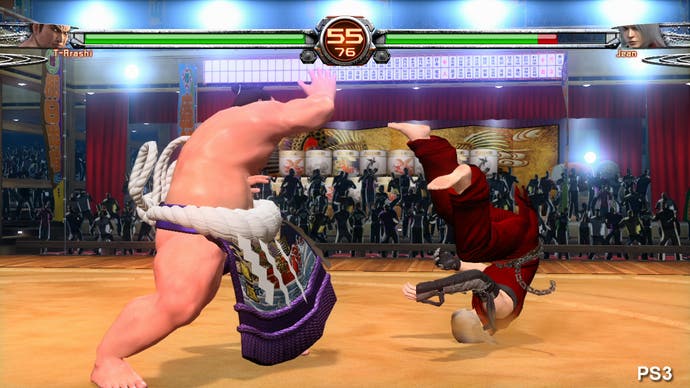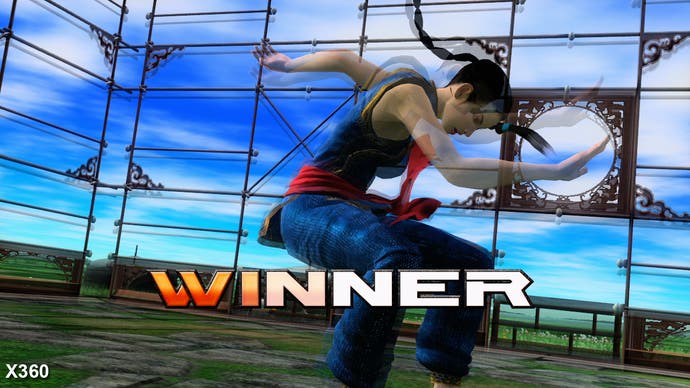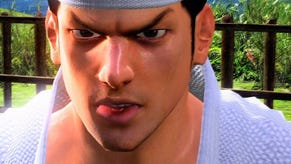Face-Off: Virtua Fighter 5: Final Showdown
Technical knockout.
Available for just £9.99 on PSN or 1200 Microsoft Points on Xbox Live, Virtua Fighter 5: Final Showdown represents something of a bargain. Not only do you get an incredibly deep and rewarding fighting game, it also represents a sizeable gameplay leap over and above its five-year-old predecessor.
The core gameplay mechanics have been reworked extensively. From a variety of moves and timing changes to revised animations and a weightier feel to the physics, the difference over Virtua Fighter 5 is considerable, while the existing cast of 18 fighters is joined by another two combatants - newcomer Jean Kujo and veteran Sumo powerhouse Taka-Arashi from Virtua Fighter 3.
The rendering technology behind the game's appearance hasn't quite changed so dramatically though, despite the switch to more powerful arcade hardware. VF5 uses Sega's older Lindbergh hardware, while Final Showdown operates on the newer RingEdge board, featuring a faster Intel CPU/NVIDIA GPU combo and more RAM.
Stages are slightly more detailed, with some improved texturing and additional light sources sprucing up various scenes, and the lighting model itself has been mildly expanded with a heavy increase in bloom and a few more reflective effects on some surfaces. Contact flashes on the characters are more pronounced, and we also have more in the way of particles being kicked up as characters are struck or fall to the ground.
The visual upgrades on offer in Final Showdown are relatively minor when compared to the extensive graphical enhancements seen between instalments in Namco's SoulCalibur series, and there's a real sense that this is still a game that has been visually designed around 2004 technology.
However, the quality of the console conversion work has improved over what we saw with Virtua Fighter 5. The team at AM2 has created a visually pleasing game which is a near-identical match across both platforms; something which our head-to-head video and comparison gallery demonstrate.
"Final Showdown ditches the 1024x1024 framebuffer resolution used in previous versions of Virtua Fighter 5 in favour of a native 720p presentation on both formats."
[Updated: resolution correction] Final Showdown ditches the 1024x1024 framebuffer resolution used in previous versions of Virtua Fighter 5 in favour of a native 720p presentation on both formats. Anti-aliasing is now also provided on both 360 and the PS3 via the inclusion of NVIDIA's FXAA (MSAA was used on the Xbox 360 version previously), although the implementation appears to be different on each console. The improvement over the stock Virtua Fighter 5 game is subtle but visible all the same. We're given a mostly smooth presentation in which the use of FXAA effectively deals with most jaggies (bar on some sub-pixel surfaces) without any negative blurring of the artwork.
While there isn't much to separate the two versions at all, we find that the FXAA implementation on the 360 actually catches more edges than on PS3, and does so more cleanly with fewer, subtler side effects. On the Sony platform, we find that the FXAA tends to very subtly blur the artwork on distant objects and on parts of the foliage, but the core texture detail remains basically unaffected on surfaces where the player is mostly likely to notice. In truth, it makes very little difference to what we are seeing in motion, and overall image quality is solid on both consoles, though the comparison video does demonstrate a greater degree of sub-pixel issues on PS3.
Curiously, we see the appearance of temporal ghosting artifacts in both versions of the game, which manifests as a transparent double image in fast-moving scenes, although it is barely visible outside of the replays and pre/post-fight sequences. We're not really sure what is causing the effect. At first we thought that AM2 might be performing some kind of temporal supersampling as an extra form of anti-aliasing when the game is in motion, but given the additional jaggies on the PS3 that doesn't appear to be the case. Or perhaps the effect is simply being used as a cheap form of motion blur, which can easily be rendered within the narrow 16.67 milliseconds window per-frame required for delivering a locked 60FPS update. Quite why it is there at all is something of a mystery.
"Puzzling is the inclusion of a really rough form of frame-blending that adds some ugly ghosting to the image. We can only think that it's some kind of cheap motion blur but the overall effect is really poor."




Texture detail, filtering, and the vast majority of the effects work is basically a match across both platforms, with none of the obvious differences we saw in Virtua Fighter 5 - such as the lack of anisotropic filtering on the 360, or the reversed normal maps on the characters. Some of our shots show a few environmental differences, such as the lack of a fence on Wolf's stage on the PS3, or different sand composition on Eileen's stage, but these are just randomised changes which occur in the game and are not isolated to either platform.
To be honest, by far the biggest difference between the two formats rests with both the gamma set-up and use of lower-precision light sources on the PS3, which can affect the intensity and appearance of certain scenes. The former results in the 360 release appearing slightly darker - although the difference here is far less obvious than in the original VF5, with more shadow detail being visible - while the latter sees light sources on the PS3 appearing lightly compressed, with different shades of detail being crushed into a shining solid glow that can sometimes be uncomfortable on the eyes.
In that respect the lighting can be more than a touch too harsh on both consoles. The use of bloom has been dialled up considerably in Final Showdown, and when combined with some overly bright light sources, this doesn't do much to aid the overall presentation of the game on certain stages.
Performance, Audio and Online
As we see in most one-on-one fighting games, maintaining a solid 60FPS update is paramount in creating a reliable and balanced gameplay experience, but in the Virtua Fighter series it is an absolute requirement. The gameplay is based around buffering your inputs, working around the number of frames it takes to execute various moves and to counter another player's incoming attack. When frame-rate drops and tearing is introduced into the mix, the game's mechanics are effectively decoupled from what we are seeing on-screen and this can leave certain players at a disadvantage - particularly where defensive play is concerned, as the attacking player can gain a per-frame advantage.
Thankfully, there aren't any issues with regards to this in Final Showdown. The game is solidly locked at a consistent 60FPS during gameplay on both consoles with no sign of any screen tear; frames are never dropped and the mechanics stay locked in tune with the frame-rate. The only time we see a mild deviation from such exemplary performance is when the game switches from pre-fight sequences to combat or when transitioning to a replay. In these instances a single frame is dropped, usually followed by one that is torn, but as gameplay remains completely unaffected it is a complete non-issue that goes undetected by the human eye.
"In most one-on-one fighting games, maintaining a solid 60FPS update is paramount in creating a reliable and balanced gameplay experience, but in the Virtua Fighter series it is an absolute requirement."
On the whole, Sega and AM2 has successfully managed to package the complete Virtua Fighter experience into a single 1.9GB download (bar the exclusion of character customisation items repositioned into a separate DLC package), although this doesn't come without there being a small compromise.
In order to keep download sizes reasonable, the game's audio has been noticeably compressed, with the low sampling rate leading to some harsh-sounding voices and effects, sounding particularly poor when the game is running through a decent set of speakers. Furthermore, the game is given a basic stereo presentation without any native surround sound options, which is a bit of a disappointment for a 2012 release. Where we do hear any form of 5.1, it is clearly artificial in nature - a lot like an amplifier's DSP conversion.
On the other hand, Final Showdown's netcode is a big step up from what we saw in Virtua Fighter 5. Online play is relatively solid on both formats, with matches feeling smooth and mostly free from any highly noticeable lag, bar a handful of games we played.
Matchmaking is painfully slow though, and finding new opponents can take anything up to a few minutes before the player is eventually paired up for a fight. Perhaps this will be less of a problem once the game's online community has had time to grow, but in the here and now it sometimes feels like more time is spent waiting for players than actually playing the game.
"Virtua Fighter 5: Final Showdown remains pure and true to its roots, with a razor-sharp focus on the raw strength of the combat mechanics and the incredible amount of depth."
Virtua Fighter 5: Final Showdown: The Digital Foundry Verdict
While other companies have attempted to take their flagship fighting games in new directions by adding in elaborate single-player modes or by experimenting with flashy new gameplay alterations, Virtua Fighter 5: Final Showdown remains pure and true to its roots, with a razor-sharp focus on the raw strength of the combat mechanics and the incredible amount of depth they provide.
Outside of the core experience, the game is a little short on features, but what is here does the job rather nicely. The arcade mode gives us the simple but effective 'six fights and a boss' model first seen in Virtua Fighter 5, while the online versus mode provides players with the ability to download and save replays, helping to bring the community feel of the coin-op into the home. There's also a training mode, and an extra 'Special Sparring' mode which is unlocked after you purchase all of the game's downloadable item packs.
All in all, Sega has done a great job of bringing Final Showdown to both consoles while including all of the features fans of the series expect to see. The poor-quality audio in both versions is something of a low point, but it shouldn't discourage anyone from picking up one of the most deeply rewarding fighting games on the market. Bar the difference in gamma set-up, slightly more refined anti-aliasing on the 360, and the use of lower-precision light sources on the PS3, both versions are equally solid. While the 360 game might possess mild advantages from a raw technical perspective, this should have no tangible effect on which version you should choose to buy.
In conclusion, Virtua Fighter 5: Final Showdown is an essential purchase for hardcore fight fans whichever console you happen to own: a technical masterclass in gameplay that can be purchased for just under a tenner on both formats. An even sweeter deal is waiting for PlayStation Plus subscribers, who are given the option to download the game without paying a penny so long as they continue to renew their subscription when it runs out.








